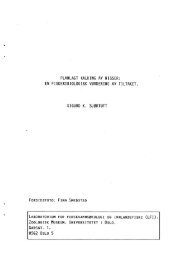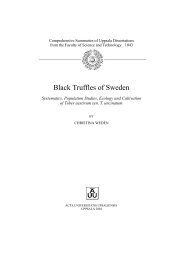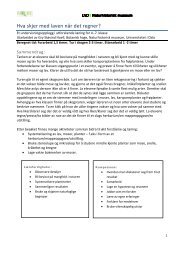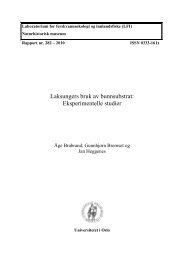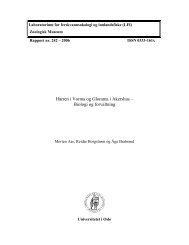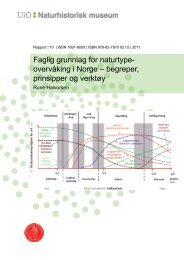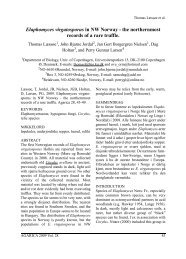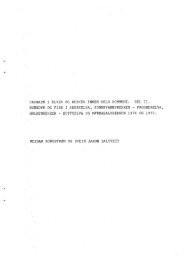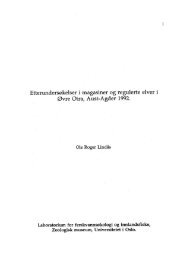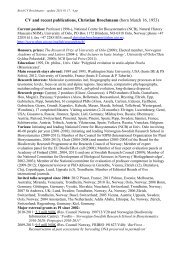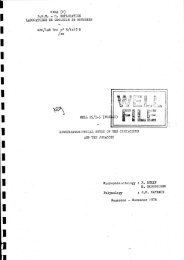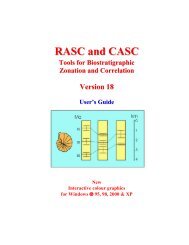Truffle trouble: what happened to the Tuberales?
Truffle trouble: what happened to the Tuberales?
Truffle trouble: what happened to the Tuberales?
- TAGS
- truffle
- www.nhm.uio.no
Create successful ePaper yourself
Turn your PDF publications into a flip-book with our unique Google optimized e-Paper software.
1092 T. Læssøe, K. Hansen<br />
a powdery mass entangled with hyphae. Castellano et al. (2004)<br />
list Paurocotylis as a saprotrophic fungus, and also Dennis (1975)<br />
noted that no obvious mycorrhizal host was found in connection<br />
with <strong>the</strong> first UK find. However, <strong>the</strong> o<strong>the</strong>r members of<br />
<strong>the</strong> clade, e.g. Geopyxis carbonaria (Vra˚lstad et al. 1998) and<br />
Tarzetta (Tedersoo et al. 2006), have been shown <strong>to</strong> be<br />
ec<strong>to</strong>mycorrhizal.<br />
Petchiomyces E. Fisch. & Mattir. 1938<br />
Type: Hydnocystis twaitesii (syn. Petchiomyces twaitesii).<br />
This genus was included in Geneaceae by Fischer (1938),<br />
followed by Gilkey (1954). Burdsall (1968) studied <strong>the</strong> type of<br />
<strong>the</strong> type species and concluded that it could not be placed in<br />
Geopora based on <strong>the</strong> presence of an epi<strong>the</strong>cium and ornamented<br />
spores. Gilkey (1939) described Petchiomyces kraspedos<strong>to</strong>ma<br />
from California, <strong>the</strong> only additional species known<br />
besides <strong>the</strong> type from Sri Lanka. P. kraspedos<strong>to</strong>ma has an apical<br />
opening with stiff, incurved hairs and smooth, ellipsoid<br />
spores. The genus should be revised, but we ad interim accept<br />
its position within <strong>the</strong> Pyronemataceae.<br />
Phaeangium Pat. 1894<br />
Type: Phaeangium lefebvrei.<br />
This genus was sunk under Picoa by Maire (1906), but resurrected<br />
by Alsheikh & Trappe (1983b), a move not accepted by<br />
e.g. Moreno et al. (2000). Gutierrez et al. (2003) described <strong>the</strong><br />
ra<strong>the</strong>r deviating mycorrhizae formed by Phaeangium lefebvrei<br />
(as Picoa) with Helian<strong>the</strong>mum species. We ad interim accept<br />
<strong>the</strong> genus (within Pyronemataceae).<br />
Sphaerosoma Klotzsch 1839<br />
Type: Sphaerosoma fuscescens.<br />
Korf (1972) placed <strong>the</strong> genus in <strong>the</strong> Ascobolaceae following<br />
previously published characters and was ad interim followed<br />
by Trappe (1979). Gamundi (1976) could not find any amyloid reaction<br />
in <strong>the</strong> type material and considered it a likely member of<br />
<strong>the</strong> Pyronemataceae (as Humariaceae tribe Otideae). Dissing & Korf<br />
(1980) followed Gamundi but stated ‘studies on fresh material<br />
are needed before <strong>the</strong> true systematic position of this genus<br />
can be evaluated’. They felt, based on circumstantial evidence,<br />
that Sphaerosoma fuscescens probably has forcible spore discharge.<br />
Montecchi & Sarasini (2000) cite Sphaerosoma as a synonym<br />
of <strong>the</strong> younger name Sphaerozone (Pezizaceae!), but it is<br />
accepted in e.g. Vizzini (2003) in <strong>the</strong> Pyronemataceae and ad interim<br />
here. Kirk et al. (2001) stated <strong>the</strong> number of species as<br />
three, but <strong>the</strong>re are 11 names in Index Fungorum currently without<br />
o<strong>the</strong>r placement. A revision would seem <strong>to</strong> be required.<br />
Stephensia Tul. & C. Tul. 1845 (syn. Densocarpa, Elderia)<br />
Type: Stephensia bombycina (Fig 7H).<br />
Knapp (1951) gave a description of <strong>the</strong> type species, whereas<br />
Fontana & Giovannetti (1987) described its anamorph. Uecker<br />
(1967) reported a similar anamorph for Stephensia shanori.<br />
Trappe et al. (1997) published a key <strong>to</strong> <strong>the</strong> species. Our placement<br />
(Fig 4) is based on sequences obtained by Perry et al.<br />
(2007). De Vi<strong>to</strong> (2003) described a new species, S. colomboi, said<br />
<strong>to</strong> differ from previously described species in being epigeous<br />
on rotten wood. Based on <strong>the</strong> published picture <strong>the</strong> wood<br />
more or less qualifies as soil, and some of <strong>the</strong> ascomata appear<br />
<strong>to</strong> be at least partly immersed. Microscopically, S. colomboi is<br />
apparently very close <strong>to</strong> S. bombycina, but some minor macroscopical<br />
differences are noted.<br />
Hypogeous pezizalean taxa currently not placed<br />
within clade A–C<br />
Carbomycetaceae Trappe 1971<br />
Trappe (1971) erected this family as a segregate from Terfeziaceae.<br />
It was based on ‘brown-walled asci borne in fertile<br />
pockets of large, inflated cells mixed with narrow, tubular<br />
ascogenous hyphae, and in <strong>the</strong> fertile pockets being separated<br />
by sterile veins of inflated cells only’. It never produces a hymenium<br />
in any kind of palisade. When dry <strong>the</strong> spore mass becomes<br />
pulverulent almost as in Elaphomyces. Eriksson (2006a)<br />
accepts <strong>the</strong> family in <strong>the</strong> Pezizales.<br />
Carbomyces Gilkey 1954<br />
Type: Carbomyces emergens.<br />
This interesting taxon, only known from three species in<br />
southwestern North America, is currently under study by<br />
K. Hansen using molecular techniques. According <strong>to</strong> Trappe<br />
(1971) its mycorrhizal status has not been clarified. At maturity<br />
<strong>the</strong> ascomata are dispersed by <strong>the</strong> wind (Trappe 1979).<br />
Zak & Whitford (1986) demonstrated <strong>the</strong> hypogeous nature<br />
of immature Carbomyces emergens, and that rodents apparently<br />
eat <strong>the</strong> (immature?) ascomata.<br />
Pezizalean truffles with unknown family placement<br />
(based on Eriksson (2006a)<br />
Delastria Tul. & C. Tul. 1843<br />
Type (mono): Delastria rosea.<br />
Not much is known about this sou<strong>the</strong>rn European/<br />
North African monotypic genus. Montecchi & Sarasini (2000)<br />
include it in <strong>the</strong> Terfeziaceae (here considered a synonym of<br />
<strong>the</strong> Pezizaceae), following Trappe (1979), and differentiate it<br />
from <strong>the</strong> o<strong>the</strong>r accepted genera in this family by <strong>the</strong> evanescent<br />
peridium, <strong>the</strong> pinkish colour of <strong>the</strong> gleba, 2–4-spored<br />
asci and a reticulate spore ornament. Castellano et al. (2004)<br />
accepted <strong>the</strong> genus in <strong>the</strong> Tuberaceae. DNA studies are clearly<br />
needed in order <strong>to</strong> clarify <strong>the</strong> position of this Tuber-like genus.<br />
Unplaced Ascomycota truffles (Eriksson 2006a)<br />
Diehliomyces Gilkey 1955<br />
Type (mono): Diehliomyces microsporus.<br />
This pest in mushroom beds (<strong>the</strong> ‘compost truffle’) is referred<br />
<strong>to</strong> as a ‘false truffle’ in Kirk et al. (2001), but its ascomyce<strong>to</strong>us<br />
nature is not disputed, and it must be considered<br />
a genuine although ra<strong>the</strong>r atypical truffle. Its position is unsettled,<br />
but it could belong in Pezizales and parallel <strong>the</strong> case<br />
of Orbicula, ano<strong>the</strong>r passively discharged, but epigeous fungus<br />
that has led a tumultuous life, but now has found its place in<br />
<strong>the</strong> Pezizales (Hansen et al. 2006). Both genera have had<br />
Eurotiales/Onygenales proposed as proper placements, mainly<br />
due <strong>to</strong> <strong>the</strong> production of small ascomata with small, globose<br />
spores. Unlike almost all o<strong>the</strong>r truffles this species is clearly<br />
not mycorrhizal. Diehl & Lambert (1930) introduced <strong>the</strong><br />
species as Pseudobalsamia microspora after having received material<br />
from an Ohio grower where <strong>the</strong> pest was ‘filling his beds



